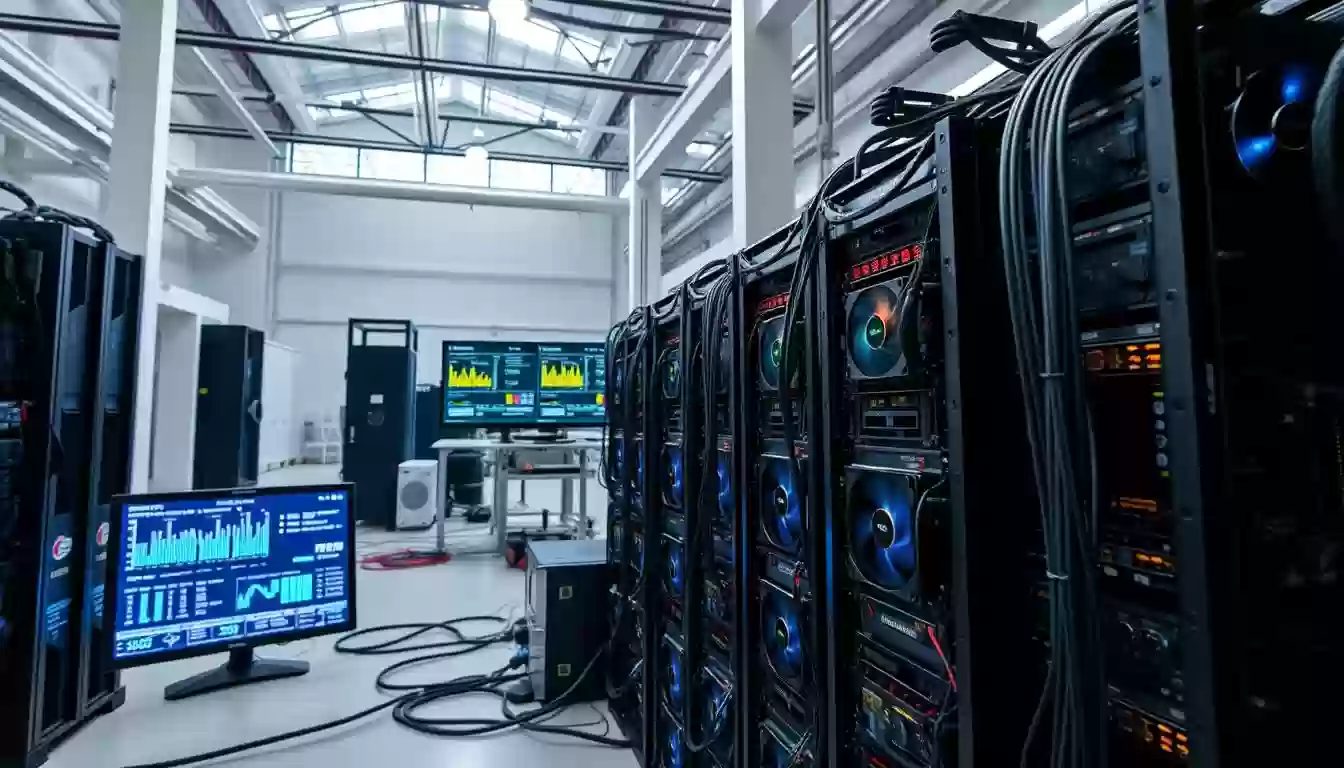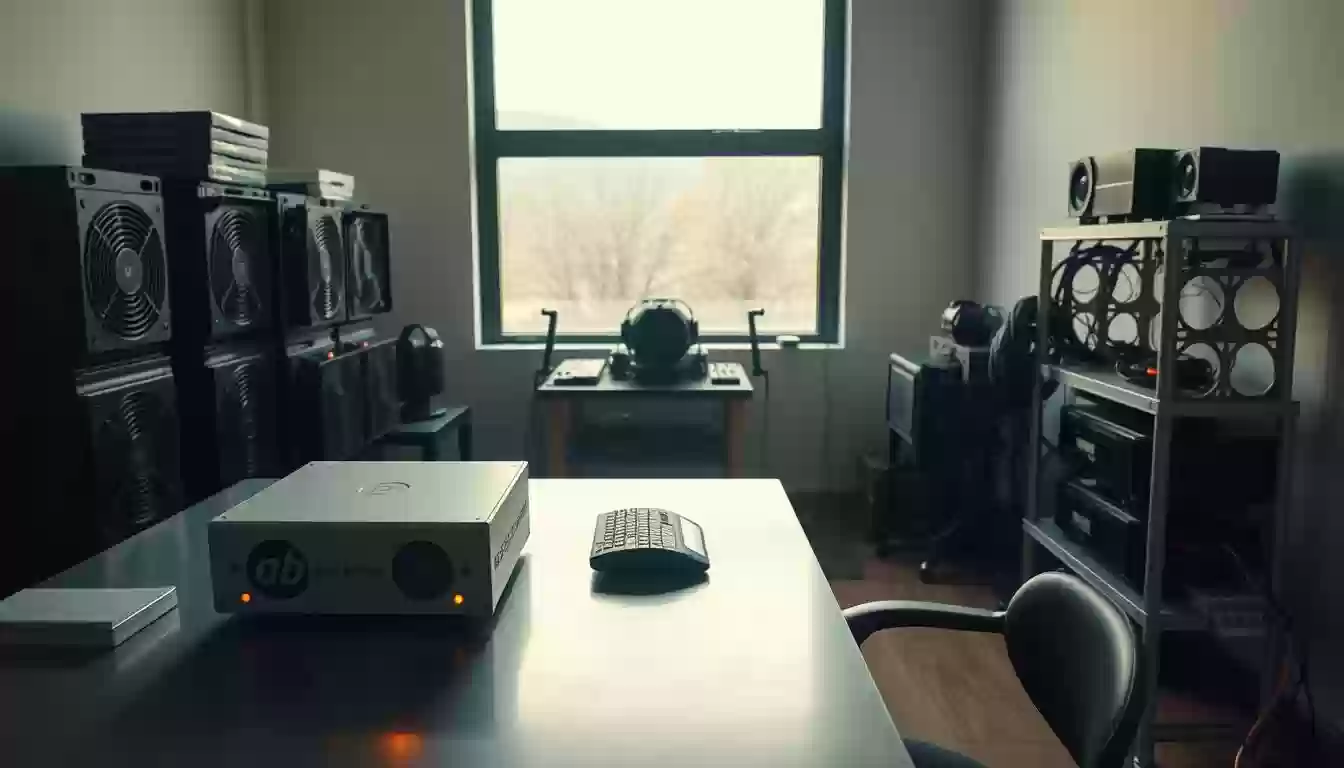Bitcoin Mining Guide: Solo Mining and Shared Mining Bitcoin
 01 Mar 25
01 Mar 25
Welcome to our comprehensive guide on Bitcoin mining, where we explore the two primary approaches: solo mining and shared mining. Whether you're a tech-curious individual or looking to dive into cryptocurrency, this guide will provide you with a clear understanding of the concepts, challenges, and rewards involved.
Solo mining is a method where a single miner operates independently, requiring significant computational power. It’s like a lottery, your chance of finding a new block depends on your hashrate. On the other hand, shared mining involves joining a mining pool, where miners combine their resources for more consistent, albeit smaller, rewards.
This guide is structured to cover both the benefits and risks of mining, including hardware requirements, energy considerations, and the impact of network difficulty. We'll also delve into technical details like hash computations using ASICs and RPC protocols, ensuring you have a well-rounded understanding.
By the end of this guide, you'll understand how to make informed decisions about your mining operations, whether you choose to go solo or join a pool. Let’s get started on this journey into the world of Bitcoin mining!
Introduction to Bitcoin Mining
Bitcoin mining is the backbone of the Bitcoin network, a decentralized system that operates without a central authority. This process is crucial for validating transactions and creating new blocks that are added to the blockchain, ensuring the network's security and integrity.
Understanding the Bitcoin Network
The Bitcoin network relies on a peer-to-peer system, where transactions are recorded on a public ledger known as the blockchain. Miners play a vital role by validating these transactions and competing to solve complex mathematical puzzles. This competition is fundamental to the network's operation, as it secures the blockchain and prevents unauthorized changes to transaction records.
The decentralized nature of Bitcoin means that no single entity controls the network. Instead, miners from around the world contribute their computational power to validate transactions and add new blocks to the blockchain. This decentralized structure is what makes Bitcoin secure and resilient.
The Role of Miners in Securing the Blockchain
Miners use specialized hardware, such as ASICs (Application-Specific Integrated Circuits), to solve the complex mathematical puzzles required to validate transactions and create new blocks. These puzzles are designed to be resource-intensive, ensuring that only those with significant computational power can solve them. Once a miner successfully solves a puzzle, they broadcast the solution to the network, and the new block is added to the blockchain.
Miners are also responsible for securing the network by making it computationally infeasible for malicious actors to alter past transactions. The energy-intensive nature of mining ensures that the network is protected from attacks, as the cost of attempting to manipulate the blockchain would be prohibitively high.
In addition to validating transactions, miners are also responsible for introducing new Bitcoin into circulation. Each new block added to the blockchain includes a certain number of newly minted Bitcoin, which is distributed to the miner who successfully solved the block. This reward incentivizes miners to continue contributing their computational resources to the network.
Miners use RPC (Remote Procedure Call) protocols, such as getblocktemplate, to communicate with the Bitcoin network. These protocols allow miners to fetch the latest block template and submit their solutions, ensuring efficient and accurate mining operations. The use of these protocols is essential for the smooth operation of the Bitcoin network.
The current block reward for mining Bitcoin is 6.25 BTC per block, which is halved approximately every four years. This reduction in reward is designed to control the supply of Bitcoin and ensure that the total number of coins in circulation does not exceed 21 million. The halving event also serves to increase the scarcity of Bitcoin over time, which can positively impact its value.
Miners also earn transaction fees, which are paid by users to prioritize their transactions. These fees are added to the block reward, providing an additional incentive for miners to continue validating transactions and securing the network. As the block reward decreases over time, transaction fees will become an increasingly important source of income for miners.
Despite the potential rewards, mining Bitcoin is not without its challenges. The process requires significant computational power and energy, making it difficult for individual miners to compete with large-scale mining operations. Additionally, the Bitcoin network's difficulty adjustment mechanism ensures that the process of finding new blocks remains challenging, even as more miners join the network.
Environmental concerns have also been raised regarding the energy consumption of Bitcoin mining. While the process does require a lot of power, there are ongoing efforts to increase the use of renewable energy sources in mining operations. This shift towards more sustainable practices could help mitigate the environmental impact of Bitcoin mining in the future.
In summary, Bitcoin mining is a complex process that is essential to the operation and security of the Bitcoin network. Miners play a crucial role in validating transactions, creating new blocks, and introducing new Bitcoin into circulation. While the process presents several challenges, it also offers significant rewards for those who are willing to invest the necessary resources.
Understanding Solo Bitcoin Mining
Solo mining is a unique approach where a single miner operates independently, without pooling resources with others. This method allows individuals to have full control over their mining operations but comes with its own set of challenges and considerations.
The Mining Process Explained
Solo mining involves several key steps. First, the miner must download and install the necessary software, such as bitcoind, which is used to connect to the Bitcoin network. Once connected, the miner uses specialized hardware, typically an ASIC (Application-Specific Integrated Circuit), to perform complex mathematical calculations.
The primary goal is to find a valid block by solving a cryptographic puzzle. This involves hashing the block header repeatedly, adjusting a value called a nonce, until the hash meets the network's difficulty target. Each attempt is computationally intensive and requires significant processing power.
Hardware and Energy Considerations
ASICs are the preferred choice for solo mining due to their high efficiency and hash rate. However, they require substantial investment and consume a lot of electricity. Electricity costs are one of the largest expenses for miners, so it's crucial to operate in regions with low power rates.
| Component | Specification | Cost |
|---|---|---|
| ASIC Miner | High-performance model | $2,000 - $5,000 |
| Power Supply | High-quality PSU | $300 - $600 |
| Cooling System | Industrial-grade fans | $200 - $400 |
The probabilistic nature of solo mining means that success is not guaranteed. Miners rely on chance to find a valid block, and the rewards can be significant but infrequent. This makes it essential to weigh the potential high rewards against the low probability of success.
Despite the challenges, solo mining offers a more decentralized approach to Bitcoin mining, distributing power among individual miners rather than large pools. This decentralization can lead to a more resilient and censorship-resistant network.

solo mining and shared mining bitcoin: An In-Depth Look
Bitcoin mining offers two distinct approaches: solo mining and shared mining. Each method has its own set of benefits and challenges, catering to different types of miners.
Defining Solo and Shared Mining
Solo mining involves a single miner operating independently, relying on their own computational power. This method offers full control but requires significant resources. Shared mining, or pool mining, combines resources with other miners, offering more consistent rewards but with shared control.
| Aspect | Solo Mining | Shared Mining |
|---|---|---|
| Control | Full control over operations | Shared control within a pool |
| Rewards | Entire block reward but less frequent | Consistent, shared rewards |
| Difficulty | High due to solo operation | Lower as efforts are pooled |
| Decentralization | Highly decentralized | Less decentralized |
When to Choose Each Approach
Miners with substantial hardware and patience may prefer solo mining for its potential high rewards and decentralization benefits. However, those seeking consistent income and lower difficulty often opt for shared mining pools, despite the fees and reduced control.
For more insights, visit Cointelegraph's guide on solo mining viability.
Detailed Comparison: Pros and Cons
Choosing between solo mining and joining a mining pool involves weighing several factors. Each method has distinct advantages and challenges that cater to different mining goals and resources.
Advantages and Challenges of Going Solo
Solo mining offers the thrill of potentially earning a full block reward, which can be significant. It also allows for greater control over your mining operations and contributes to a more decentralized network. However, the challenges are substantial. The probability of successfully mining a block is low, requiring considerable computational power and energy. High upfront hardware costs and intensive energy needs further add to the barriers. Despite these challenges, solo mining appeals to those who value decentralization and are willing to take on higher risks for greater rewards.
Benefits of Joining a Mining Pool
Mining pools provide steadier income through combined computational power, making block rewards more consistent. Pools distribute rewards proportionally, ensuring miners receive earnings based on their contribution. While individual rewards are smaller, the predictability and lower risk make pools appealing. Operational differences include fee structures, typically ranging from 1% to 3%, and the sharing of computational work. For instance, F2Pool charges a 4.80% commission, while BTC.com charges 4.27%. These pools offer reduced risks and more stable income, especially for those with limited resources.
| Aspect | Solo Mining | Mining Pool |
|---|---|---|
| Reward Structure | Full block reward, but less frequent | Proportional share of block reward |
| Control | Full control over operations | Shared control within the pool |
| Risk | High risk due to low success probability | Lower risk with consistent payouts |
| Cost | High upfront hardware and energy costs | Lower costs with shared resources |
| Decentralization | Highly decentralized | Less decentralized |
For miners seeking consistency, mining pools like F2Pool and BTC.com offer predictable income with lower risks. Meanwhile, solo mining remains a high-risk, high-reward option for those with the resources and patience. Evaluating your circumstances, such as hardware, energy costs, and risk tolerance, is crucial in choosing the right strategy. Whether you prefer the autonomy of solo mining or the stability of a pool, understanding these factors will guide your decision.
For more insights, visit this guide to explore which mining strategy aligns best with your goals.
Technical Aspects and Protocols in Bitcoin Mining
Mining software plays a crucial role in Bitcoin mining by constructing block headers and collecting transactions. This process is essential for creating valid blocks that can be added to the blockchain.
Mining Software and Getblocktemplate RPC
Mining software interacts with the Bitcoin network through the getblocktemplate RPC protocol. This protocol provides miners with a block template that includes essential details like coinbase information and a list of transactions to be included in the block. The miner's hardware then uses this template to attempt solving the cryptographic puzzle required to validate the block.
The getblocktemplate RPC method offers comprehensive data, enabling miners to construct valid blocks efficiently. However, it requires significant bandwidth and computational resources, which can be a challenge for individual miners.
Insights on the Stratum Protocol
The Stratum protocol offers a more streamlined approach to data exchange. It minimizes the amount of data transferred between miners and pools, improving communication efficiency. This protocol is particularly beneficial for pool mining, where multiple miners collaborate to solve blocks more consistently.
ASIC hardware is designed to process the 80-byte block header efficiently. These devices iteratively generate nonces and perform hash computations, seeking a valid hash that meets the network's difficulty target. This iterative process is fundamental to the mining operation and ensures the security of the Bitcoin network.
| Protocol | Getblocktemplate | Stratum |
|---|---|---|
| Data Transfer | High | Low |
| Bandwidth Usage | Higher | Lower |
| Efficiency | Moderate | High |
| Suitability | Solo Mining | Pool Mining |
Understanding these protocols is essential for optimizing mining performance and ensuring effective communication between miners and pools. By leveraging the right protocol, miners can enhance their operational efficiency and contribute more effectively to the network's security.

Critical Factors Impacting Mining Success
Several key elements determine the success of mining operations. Understanding these factors is essential for making informed decisions and optimizing your mining strategy.
Influence of Network Difficulty and ASIC Hardware
Network difficulty directly impacts the likelihood of mining a block. As difficulty rises, the computational power required increases exponentially, making it harder for individual miners to succeed. For instance, to mine a block in 2025, a miner needs approximately 166,500 TH/s of hash power, equivalent to 497 Antminer S21 Hydro units, costing millions of dollars. High-performance ASIC hardware is crucial for efficient mining, as it significantly boosts hash rates, enhancing the chances of solving complex mathematical puzzles.
Managing Energy Consumption and Costs
Energy costs are a major expense in mining. Electricity prices vary by region, with areas like Iceland and Canada offering cheaper power, thus increasing profitability. Investing in energy-efficient hardware, such as 3nm ASIC chips, can reduce consumption while maintaining performance. Additionally, utilizing renewable energy sources can lower operational costs and environmental impact.
| Factor | Impact | Example |
|---|---|---|
| Network Difficulty | Reduces mining success probability | 2025 difficulty expected to be significantly higher |
| ASIC Hardware | Enhances hash rate and efficiency | Antminer S21 Hydro for high hash rates |
| Energy Costs | Affects profitability based on region | Iceland and Canada offer cheaper electricity |
Understanding hash rates and balancing operational costs with potential rewards is vital. High hash rates improve mining success, but electricity and hardware expenses must be managed to ensure profitability. Careful planning is necessary to navigate these challenges effectively.
Future Trends and Network Decentralization
The future of Bitcoin mining is poised for significant transformation, driven by technological advancements and a growing interest in decentralized networks. As more individuals and organizations explore mining, the landscape is expected to evolve in ways that enhance security and accessibility.
The Shift Towards Home Mining and Decentralization
Home mining is gaining traction as individuals seek to contribute to the network's security. This trend could reduce the dominance of large mining pools, promoting a more decentralized system. With more participants, the network becomes harder to manipulate, enhancing its resilience.
According to projections, if a larger percentage of Bitcoin holders in the U.S. (estimated at 67 million) and other countries begin mining, the global hashrate could increase by 9.63%. This growth would not only boost security but also distribute mining power more evenly, countering the influence of large-scale operations.
Innovations in Mining Technology
Advancements in ASIC hardware are reshaping the industry. Newer models, such as those using 3nm chips, offer higher hash rates and improved energy efficiency. These innovations make mining more accessible and sustainable, attracting both hobbyists and serious miners.
| ASIC Model | Hash Rate | Power Consumption | Cost |
|---|---|---|---|
| Antminer S21 Hydro | Up to 200 TH/s | Approx. 3,000W | $5,000 - $10,000 |
| Bitaxe Gamma | 80-130 GH/s | 7-8W | $180 - $220 |
| NerdNos | 0.8-1.3 GH/s | 5V/2A | Under $200 |
Emerging technologies like the Bitaxe Gamma and NerdNos are making mining more affordable and energy-efficient. These devices are perfect for home setups, allowing individuals to participate without significant investment. As prices for these devices are projected to rise due to demand, accessibility might improve, further decentralizing the network.
The shift towards decentralized mining presents both opportunities and challenges. While it enhances security and reduces corporate dominance, it also requires balancing energy consumption and operational costs. As the industry evolves, the focus will be on sustainable practices and innovative hardware solutions to ensure a resilient and accessible network for all.
Conclusion
In conclusion, understanding the nuances of mining approaches is crucial for a robust Bitcoin network. This guide has explored the key differences between solo and shared mining, highlighting their unique advantages and challenges. Solo mining offers autonomy and contributes to decentralization, while shared mining provides stability and consistency through pooled resources.
Network security and decentralization remain foundational goals, ensuring the Bitcoin network's resilience and integrity. As mining technology evolves, innovations like energy-efficient hardware and renewable energy integration promise a more accessible and sustainable future for miners of all levels.
Whether you're evaluating strategies or embracing new opportunities, the insights from this guide can help shape your approach. The future of Bitcoin mining is bright, with decentralization and technological advancements paving the way for a resilient and inclusive network.
FAQ
What is the primary difference between solo mining and pool mining?
Solo mining involves a single miner solving complex mathematical puzzles independently, while pool mining combines the computational power of multiple miners to increase the chances of solving blocks and sharing rewards.
What hardware is required for solo mining?
Solo mining requires powerful ASIC (Application-Specific Integrated Circuit) devices designed specifically for Bitcoin mining, as they offer the necessary hashrate to compete effectively.
How does network difficulty impact mining success?
Network difficulty adjusts every 2016 blocks, making it harder or easier for miners to find a new block. Higher difficulty means more computational power is needed, affecting both solo and pool mining success rates.
What are the energy considerations for mining operations?
Mining consumes significant electricity, so it's crucial to consider energy costs and efficiency. Using energy-efficient hardware and accessing low-cost power sources can help mitigate these expenses.
How does network security benefit from mining?
Miners validate transactions and secure the Bitcoin network by solving complex hashes, ensuring the integrity and immutability of the blockchain in exchange for block rewards and transaction fees.
What are the risks involved in solo mining?
Solo mining risks include lower chances of finding blocks due to high network difficulty, potentially leading to prolonged periods without rewards, despite the possibility of higher payouts when successful.
How do mining pools distribute rewards?
Rewards in pool mining are distributed proportionally based on each miner's contributed hashrate, ensuring consistent, smaller payouts compared to the variable rewards in solo mining.
What trends are emerging in Bitcoin mining?
There is a growing trend towards home mining and decentralization, with innovations in mining technology aiming to make the process more accessible and energy-efficient for individual miners.





























